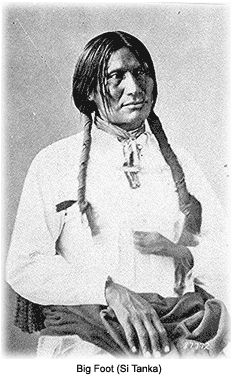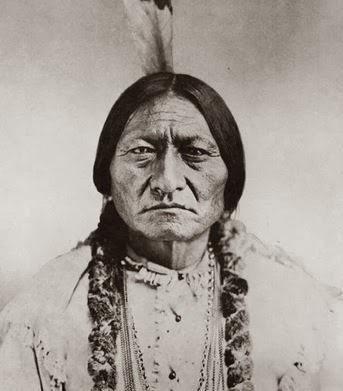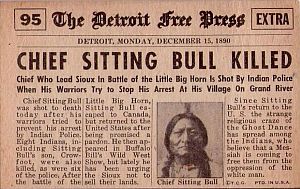
Si Tanka (Spotted Elk)
Chief Big Foot

Jumping Badger
Chief Sitting Bull

Click on image for larger view
 Si Tanka (Spotted Elk) Chief Big Foot |
 Jumping Badger Chief Sitting Bull |
 Click on image for larger view |
|
| On the morning of December 29, 1890, the Sioux
chief Big Foot and approximately 350 members of his tribe camped on the
banks of Wounded Knee creek. A force of U.S. troops, energized by the
notion of arresting Big Foot and neutralizing his warriors, anxiously
surrounded the camp. The air was thick with the tension and pressure
that had been brewing for several months. The once pride full Sioux had
finally come to terms with the fact that their nomadic lifestyle was no
longer feasible, that their main source of food, the buffalo, was gone,
and that they seemed destined to live out their lives confined to
reservations dependent on Indian Agents for their existence. In a frantic attempt to return to their glory days, many Sioux sought deliverance in a new mysticism preached by a Paiute shaman called Wovoka. Emissaries from the Sioux in South Dakota traveled to Nevada to listen to his message. Wovoka called himself the Messiah and prophesied that the dead would “soon join the living in a world in which the Indians could live in the old way surrounded by plentiful game. A tidal wave of new soil would cover the earth, bury the whites, and restore the prairie.” To accelerate the incident, the Indians were instructed to dance the Ghost Dance. Many dancers were dressed in vibrantly colored shirts decorated with images of eagles and buffaloes. The Indians believed that these "Ghost Shirts" would protect them from the bluecoats' bullets. During the fall of 1890, the Ghost Dance spread through the Sioux villages of the Dakota reservations, revitalizing the Indians and disseminating panic throughout the white community. A desperate Indian Agent at Pine Ridge sent a telegram to his superiors in Washington, describing the dancing as dangerous and threatening. Hence the order was dispatched to arrest Chief Sitting Bull at the Standing Rock Reservation. Sitting Bull was killed in the attempt on December 15. Chief Big Foot was next in line. When Big Foot received word of Sitting Bull's death, he guided his people south to seek protection at the Pine Ridge Reservation. He led his band toward Pine Ridge, however, he became ill from pneumonia during the trip and was forced to travel in the back of a wagon. The army intercepted the band on December 28 and brought them to the edge of the Wounded Knee to camp. Upon approaching Porcupine Creek, the band saw four troops of cavalry approaching. A white flag was instantly run up over Big Foot's wagon. General Nelson Miles, commander of the Military Department of the Missouri, was in charge of the army in this area, and therefore could be considered the most important single non-Indian source of information on Wounded Knee. When the soldiers and the Indians finally met up, Big Foot arose from his sick bed to greet Major Samuel Whitside of the Seventh Cavalry. His blankets were stained with crimson and blood dripped from his nose as he spoke. Whitside informed Big Foot of his orders to take the band to their camp on Wounded Knee Creek. Big Foot responded that they were headed that way, to Pine Ridge. The major wanted to disarm the Indians immediately, but was talked out of it by his scout John Shangreau, in order to prevent instigating a fight right then and there. Thus they agreed to wait until they reached camp. Then, in a moment of sympathy, the major ordered his army ambulance to transport the ill Minneconjou chief, and provide him with a warmer and more comfortable ride. They then proceeded toward the camp at Wounded Knee Creek, led by two cavalry troops with the other two troops bringing up the rear. They arrived at their destination on the cusp of twilight. A single shot fueled the already charged atmosphere into a full-fledged eruption within a matter of seconds. Indian braves rushed to retrieve their weapons as troopers fired aimlessly into the Sioux camp. Clouds of gunsmoke permeated the air as men, women and children scrambled desperately to save their own lives and the lives of their loved ones. When the smoke cleared and the gunfire finally ceased, approximately 300 Sioux were dead, including the targeted victim, Big Foot. Twenty-five American soldiers were also found dead and 39 more were wounded, most by their own shrapnel and bullets. As the remaining troopers began the dour chore of getting rid of the corpses, a blizzard swept in from the North. A few days later they returned to complete the job. Scattered fighting continued, but the massacre at Wounded Knee effectively stifled the Ghost Dance movement and ended the Indian Wars. The Massacre of Wounded Knee became a wake up call for the nation, regarding the lies and deceit of the U.S. Government towards Native Americans. The more land that was promised, the more it was taken away due to what appeared to be the arbitrary whims of Congress. The mass graves at Wounded Knee became a symbol to the Indians never to forget and never to trust the white man again. |
Nation Visitors Since March 8, 2013